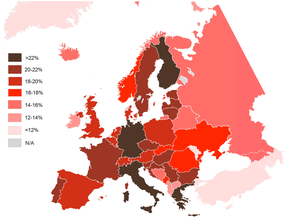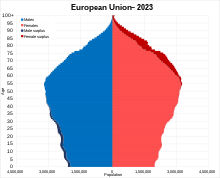
Back Stárnutí Evropy Czech Γήρανση της Ευρώπης Greek Envejecimiento de Europa Spanish Vieillissement de l'Europe French Invecchiamento dell'Europa Italian ヨーロッパの高齢化 Japanese Стареењето во Европа MK Старение Европы Russian
This article needs to be updated. (August 2022) |



The ageing of Europe, also known as the greying of Europe, is a demographic phenomenon in Europe characterised by a decrease in fertility, a decrease in mortality rate, and a higher life expectancy among European populations.[1] Low birth rates and higher life expectancy contribute to the transformation of Europe's population pyramid shape. The most significant change is the transition towards a much older population structure, resulting in a decrease in the proportion of the working age while the number of the retired population increases. The total number of the older population is projected to increase greatly within the coming decades, with rising proportions of the post-war baby-boom generations reaching retirement. This will cause a high burden on the working age population as they provide for the increasing number of the older population.[2][3]
Throughout history many states have worked to keep high birth rates in order to have moderate taxes, more economic activity and more troops for their military.[4]
Population ageing is observed in most European countries today.
- ^ Giuseppe Carone and Declan Costello (2006). "Can Europe Afford to Grow Old?". International Monetary Fund Finance and Development magazine. Retrieved 15 December 2007.
- ^ "Population structure and ageing - Statistics Explained". Ec.europa.eu. Retrieved 28 December 2017.
- ^ Iburg, KM; Charalampous, P; Allebeck, P (24 November 2022). "Burden of disease among older adults in Europe—trends in mortality and disability, 1990–2019". European Journal of Public Health. 33 (1): 121–126. doi:10.1093/eurpub/ckac160. PMC 9897992. PMID 36421036.
- ^ "Europe's Shrinking, Aging Population". Stratfor.com. 13 June 2012. Retrieved 29 March 2017.